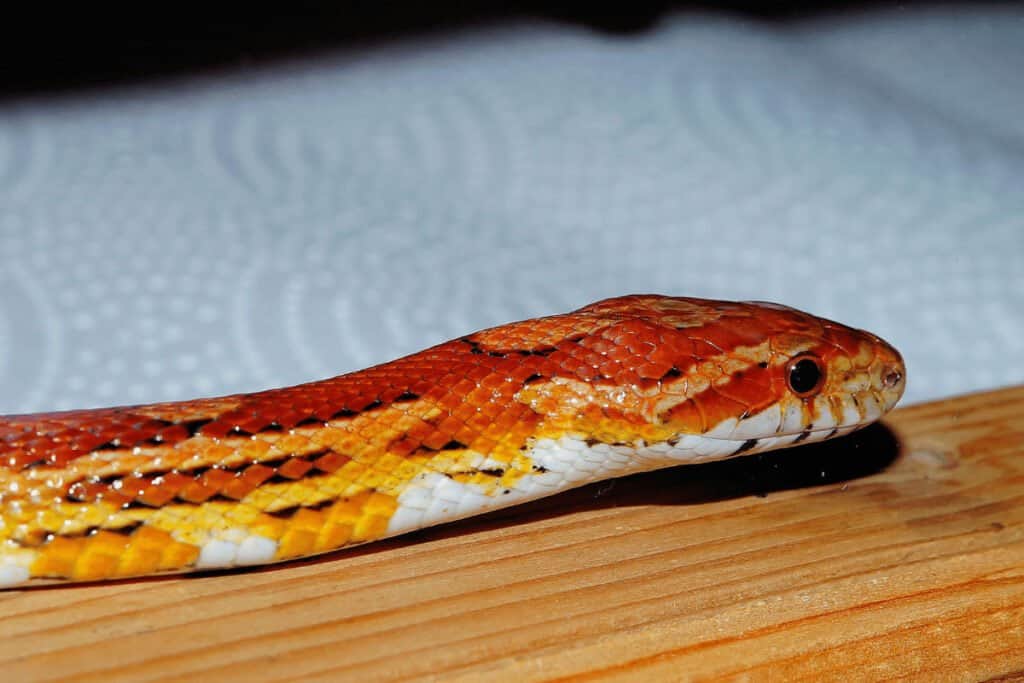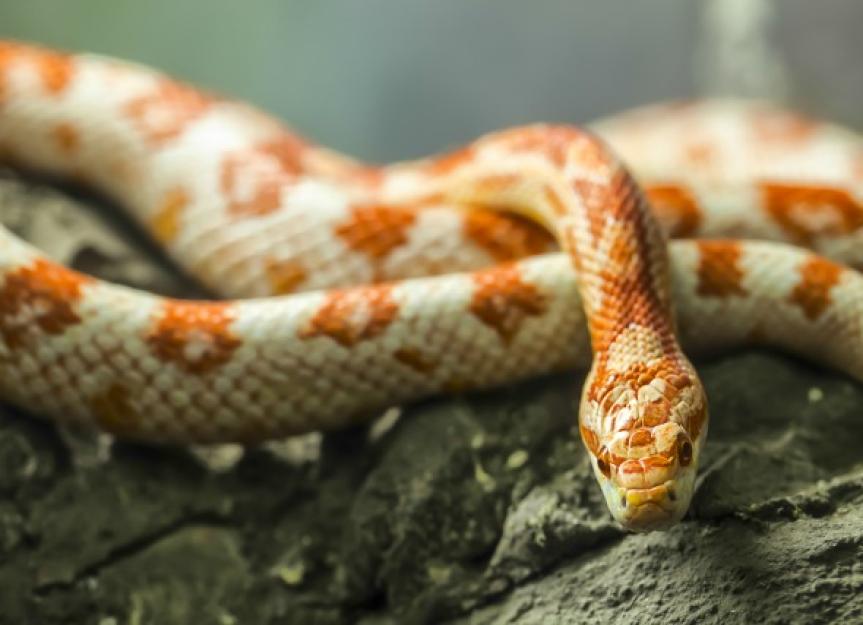Nowadays, raising ornamental snakes such as Milk snakes, Ngo snakes, and King snakes… are increasingly popular. However, if you do not understand how to care for and nurture pet snakes, they will grow slowly. Not even a long life. The article Common Health Issues With Corn Snakes will help you understand the health problems of corn snakes.
The habitat of corn snakes will affect their health
The health of corn snakes can be significantly impacted by their surroundings. It’s crucial to comprehend the native habitat of corn snakes and make an effort to as closely resemble it as you can to give an appropriate setting for your corn snake.
The southeastern region of the United States is home to corn snakes, who often live in marshes, fields, and woodlands. Although they are mostly terrestrial, they have been observed climbing trees and plants.

To grow in captivity, corn snakes need a certain temperature range, humidity level, and lighting setup. A basking area that gets up to 90 to 95 degrees Fahrenheit and a colder section that stays at 75 to 80 degrees Fahrenheit should be on opposite sides of the cage.
It is recommended to have a full-spectrum UVB lamp on for 12–14 hours every day, and to frequently clean and sanitize the cage. To replicate their natural environment and give them a place to hide and relax, it’s also crucial to include climbing branches and a suitable hiding place in the enclosure.
For your corn snake’s general health and well-being, it is essential to provide a proper environment. It is also significant to regularly check on the enclosure’s conditions and make any necessary improvements.
Food sources of corn snakes will affect their health
Their diet can significantly impact the health of corn snakes. Since corn snakes are carnivorous, their main prey in the wild is rodents like mice or rats. They should be fed a diet of live prey that is the right size in captivity, or pre-killed prey.
To ensure the snake gets all the essential nutrients, it’s crucial to offer a varied diet. One species of prey should not make up the majority of a meal to prevent nutritional deficits.
Generally speaking, it is recommended to feed live prey to corn snakes because they have a natural tendency to hunt and kill their meal. However, pre-killed prey can also be used if you don’t feel comfortable doing this.

Additionally, it’s crucial to keep an eye on the snake’s weight and modify its feeding schedule as necessary. Overeating can result in obesity and other medical issues.
Additionally, make sure the prey you provide the snake is clear of sickness because doing so might affect its health.
Your corn snake’s entire health and well-being depend on proper nutrition, so if you have any queries or concerns regarding your snake’s food, it’s necessary to speak with a veterinarian or a knowledgeable reptile keeper. This is further information in Common Health Issues With Corn Snakes.
Caring for a corn snake with prolonged vomiting
Corn snakes vomit due to psychology
One of the main causes of this phenomenon is the psychology of snakes. Usually snakes sold in pet stores are very small in size. Most of them are newly hatched baby snakes, weak resistance, sensitive spirit.
After spending a long time moving, their health will decline sharply. Furthermore, during this process they are usually not given food or water to drink. Just being fed a little bit more will immediately cause indigestion, leading to vomiting.
Snakes need to rest after feeding. They often look for a warm place to digest food. Usually this process will take about 1 week. Right after the snake eats, you absolutely must not touch, hold in your hand or act to startle them. Because the instinct of snakes is to vomit food to run away when feeling scared.
Corn snake vomiting due to diet
Corn snakes eat mainly white mice or small animals such as frogs and lizards. Foods such as fish, eggs, and large animals are not suitable for them. If the prey is too large, the snake will have to vomit because they cannot digest it.
Spacing between meals that is too close or uneven will also cause snakes to have indigestion. You should base on the size of their prey to calculate a reasonable time. The size of the snake’s prey is important.
Choose baits of the same size. If the prey is large, give the corn snake more time to digest, to avoid overloading their stomach. This is further information in Common Health Issues With Corn Snakes.
Caring for sick and injured corn snakes
Corn snakes have respiratory infections
A common respiratory infection in Corn Snakes is an upper respiratory infection. Very rare cases of lower respiratory tract infections. Usually caused by bacteria. This is mainly due to low ambient temperature, poor ventilation or too high temperature.

The main symptoms include: Open mouth, difficulty breathing, sneezing, snake’s back arched back, a lot of saliva, runny nose. Ensuring a nurturing environment can only prevent upper respiratory tract infections. If your poor Corn Snake has this disease, contact your veterinarian quickly. This is further information in Common Health Issues With Corn Snakes.
External wound
Corn Snakes raised indoors are not as dangerous as snakes in the wild. Therefore, Corn Snakes kept in the house will usually not be injured. If they are accidentally injured such as a cut or a friction injury, the owner can use diluted soapy water or physiological saline to clean the wound.
Then gently pat dry with a paper towel, then apply a thin layer of antibiotic ointment. Most antibiotics used in humans are safe for Corn Snake. However, be careful with drugs that contain anesthetic ingredients.
When seriously injured, after recovering from the disease, it will make it difficult for them to molt. Therefore snakes need your help to remove the “stubborn” skin.
Also, remember to wash your hands and wear rubber gloves when handling pet snake wounds. This is further information in Common Health Issues With Corn Snakes.
Corn snake refuses to eat
Many new and inexperienced players often do not understand why their snake refuses to eat. A lot of people don’t know what corn snakes eat, so they feed them arbitrarily. Their food is lizards, mice or small birds. Do not feed them livestock, fish or eggs.
In the first few days, it is normal for corn snakes to stop eating. After a few days, they will get used to it and will start to hunt for food. When feeding snakes should not stand next to see. If disturbed, they will immediately stop eating because in the wild when eating prey, snakes are very susceptible to attack.
If the snake refuses to eat, you can wait 48 hours to feed them again. Food should be changed frequently. If the snakes are small, you can feed them newborn mice. Small snakes eat 1 mouse each, adult snakes eat 2 each. Each meal is 7-10 days apart.
After eating for 48 hours, you should not disturb it. Increasing the house temperature to 2-3 degrees will help them digest better. If vomiting occurs, immediately stop feeding them and add vitamins. Also provide them with clean water.
When raising corn snakes as an ornamental, you do not need to play with them every day. Since snakes are not like cats and dogs, they only need a warm and quiet place to thrive. Should not often catch snakes out to consider. If stimulated they will very easily die. This is further information in Common Health Issues With Corn Snakes.
Conclusion
Understanding the health problems of corn snakes will help the process of raising and taking care of corn snakes better. Hope the article Common Health Issues With Corn Snakes will provide you with useful information.

